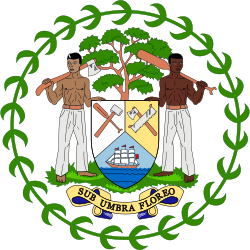| Coat of arms of Belize | |
|---|---|
 | |
| Armiger | Charles III in Right of Belize |
| Adopted | 1981 (standardised in 2019) |
| Crest | A mahogany tree proper[1] |
| Shield | Party per pall inverted, 1st Argent a paddle and a squaring axe proper in saltire 2nd Or a saw and beating axe proper in saltire 3rd per fess bleu celeste and barry wavy or vert azure above the last a sailing ship proper[1] |
| Supporters | Dexter a Belizean Mestizo woodsman proper garbed in trousers argent bearing in the dexter hand a beating axe, sinister an Afro Belizean woodsman proper garbed in trousers argent bearing in the sinister hand a paddle proper[1] |
| Compartment | A grassy field proper[1] |
| Motto | SUB UMBRA FLOREO "Under the shade I flourish" |
| Other elements | The whole surrounded by a wreath of 25 leaves proper[1] |
The coat of arms of Belize or national seal of Belize was adopted upon independence, and the current coat of arms is only slightly different from that used when Belize was a British colony (the Union Jack has been removed, and a Mestizo woodcutter has replaced one of the supporting Afro-Belizean woodcutters).[1][2]
The circular border of the coat is formed by 25 leaves. Within the circle is a mahogany tree, in front of which is a shield tierced per pall inverted. Within the shield are the tools of a woodcutter in the upper sections and a ship in the lower one. These are symbolic of the importance of mahogany in the 18th- and 19th-century Belizean economy.[3]
The flag of Belize features the coat of arms in its centre.
- ^ a b c d e f "Belize Flag, Coat of Arms, National Anthem". Belize.com. Archived from the original on 3 July 2023. Retrieved 29 February 2020.
- ^ Fox-Davies, Arthur Charles (1915). The Book of Public Arms: A Complete Encyclopæeia of All Royal, Territorial, Municipal, Corporate, Official, and Impersonal Arms. London: T. C. & E. C. Jack. pp. 118–119. Retrieved 29 February 2020.
- ^ "The National Symbols". Government of Belize. Archived from the original on 23 September 2015. Retrieved 13 October 2013.